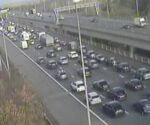The troubled UK city plagued by drugs | UK | News

Residents of Bradford say the city has ‘gone downhill’ over the years (Image: Andy Stenning/Daily Express)
You can’t miss him, right in front of Bradford’s gleaming City of Culture booking office, a man lies slumped on the steps, unconscious from what’s believed to be the drug known as spice. For Councillor Rebecca Poulsen, it’s a scene that sums up the uneasy contrast at the heart of the city: “People have literally had to step over them to get inside,” she told the Express. “It’s very unpleasant for visitors coming into the city centre. We’ve had people completely comatose outside the very place meant to showcase Bradford’s transformation.”
Bradford may be proudly celebrating its year as the UK City of Culture, with fresh flower beds, pedestrianised squares and glossy new seating areas, but residents and officials alike admit that behind the facelift, serious social problems persist, especially drug use and antisocial behaviour in the city centre.
READ MORE: The little village rammed with 70 independent stores and not one abandoned shop
READ MORE: The pretty little UK market town where locals are ‘sick of tourists’

Simon Cope has lived in the city his whole life and says things have got worse (Image: Andy Stenning/Daily Express)
Few have watched the changes unfold over the years more closely than Simon Cope, 64, who has lived in Bradford his whole life and now works as a city cleaner.
“It didn’t used to be so bad,” he says. “More jobs have disappeared and people have low incomes, so they’re turning to drugs. At night, you can always see users wandering around or sleeping on the streets. It’s sad to see.”
He believes the decline in employment opportunities and visible poverty have left deep marks. “Not everyone in tough situations is on drugs,” he adds. “There was one lad I spoke to who was sleeping rough, and he had a university degree. But it’s worse now than it’s ever been.”

Shumaila Murthza is concerned about safety in the city (Image: Andy Stenning/Daily Express)

Rough sleepers are a common sight in the city (Image: Andy Stenning/Daily Express)
For Shumaila Murthza, who has lived in Bradford for eight years, safety is the biggest concern.
“There are some areas with high crime levels, and often drug users seen on the streets taking I don’t know what,” she says, while walking through the city centre with her young son. “I don’t feel safe here at night and avoid it whenever I can. I wouldn’t feel safe letting my son walk around by himself, even if he was older.”
Her comments echo those of other parents who tell the Express they plan their routes carefully, especially after dark.
While Bradford clearly has its challenges not everyone agrees that the city is in decline.

Elizabeth Lephard defended the town’s reputation (Image: Andy Stenning/Daily Express)

Rebecca Poulsen says drug takers unconscious on park benches isn’t a great look (Image: Andy Stenning/Daily Express)
Elizabeth Lephard, 47, an NHS worker who lives just outside the city, says she’s seen a visible improvement in recent years.
“I think it’s a lovely place,” she says. “We’re City of Culture this year and you can really see the effort the council has put in to improve the look of the place. Bradford gets a bad rep, but it’s got beautiful countryside not far from here.”
For Councillor Rebecca Poulsen, the problem isn’t the appearance of the city, it’s what happens within it.
“The city centre looks beautiful now, lots of green space and pedestrianised streets,” she says. “But drugs remain a real issue. You can be sitting in a lovely new park area on your lunch break, and there are people comatose on the bench next to you. It’s not a great look.”
She says deprivation continues to drive the problems and explains: “Bradford has a very high poverty index, particularly in the city centre. Income levels are low, and high-quality jobs aren’t easy to find. There’s a massive skills issue, it all feeds into it.”
Cllr Poulsen also raises concerns about the rise of illegal e-scooters, which are banned from public roads but commonly seen speeding through City Park. “They’re dangerous and intimidating. I’ve had to physically stand in front of them to make them stop,” she says.

Matt Edwards says Bradford’s issues are more visible to visitors than in other cities (Image: Andy Stenning/Daily Express)
Matt Edwards, a local councillor and Green Party group leader, says the issues are not unique to Bradford, but feel more visible here.
“Drug and alcohol dependency is a major reason people avoid the city centre,” he explains. “Some of that’s linked to homelessness, some to other issues, but we know it’s a barrier, as it is in every major city.
“What makes it feel worse in Bradford is that the city centre is quieter. In Leeds or Manchester, you see similar things, but there’s so much footfall that it’s less noticeable. Here, a few people in distress stand out more.”
Cllr Edwards links the city’s current crisis to austerity and years of cuts to local government funding. “Ultimately, it stems from a whole host of things [but] most of them track back to austerity under the coalition government,” he says.
“Millions were stripped from local councils and support for the most vulnerable. Adult social care budgets were slashed, so people with high needs but who didn’t meet the legal threshold just fell through the cracks.
“It’s the same for police, fewer officers on the ground, and for charities and support services who’ve had their funding cut too.”
Noreen Akhtar, assistant director for neighbourhoods and communities at Bradford Council, defends the authority’s record, saying drug and alcohol issues are being treated as public health challenges rather than simply policing matters.
“Bradford isn’t an outlier when it comes to drug dependency,” she says. “These are vulnerable individuals who need long-term support. Addiction can stem from years of trauma, and it isn’t easy to break.”
Akhtar says the council’s Drug and Alcohol Partnership works closely with community groups and health providers to support people whether they want to enter formal treatment or just need day-to-day help. “The aim is to support people, not isolate them,” she says.

Shaz J says the drug takers do at least keep themselves to themselves (Image: Andy Stenning/Daily Express)
She adds that the city has seen “a very proactive increase in city centre policing” in recent months and has invested heavily in improved lighting and safety schemes, especially for women and girls.
“We’ve been working with the West Yorkshire Mayor’s Office and police on initiatives to make the city centre both safe and feel safe,” she says. “That includes better lighting, more visible policing, and education programmes in schools and colleges.”
One such initiative, Jog On, has won awards for protecting female runners. “We’ve used undercover officers and vehicles to intercept and deal with people who harass or threaten women out jogging,” Akhtar explains.
Despite the public concern, some locals say the problem looks worse than it is.
Shaz J, 25, who has lived in Bradford for a decade, says: “Yes, there are many drug users around, but I don’t feel they pose more of a problem than in any other city. They keep to themselves and are usually unconscious. I don’t feel unsafe around them, but I see why others might.”
The picture emerging from Bradford is a city of two faces: a place of rich cultural heritage and ambitious redevelopment, yet shadowed by poverty and public drug use that continues to tarnish its reputation.
Being the UK’s City of Culture could help change perceptions. But for now, scenes like those outside the booking office, where visitors are forced to step over the city’s most vulnerable, remain an uncomfortable reminder of the work still to be done.









